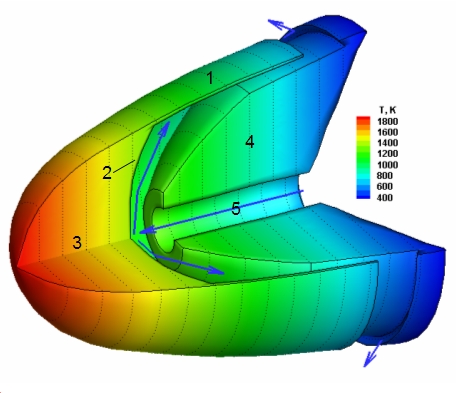
The inner shell of hypersonic vehicle (HSV) may be heated to sufficiently high temperatures and itself to heat the internal arrangements not only by a thermal conductivity but also by means of a thermal radiation. Lowering the temperature inside the HSV to normal conditions is possible under conditions of forced convection, for example, by blowing a cold gas. The calculations are performed for the axisymmetrical hypothetical internal construction of HSV nose part, the outer streamlined shell of which has the form of a blunted cone. The conditions for aerodynamic heating corresponded to M = 6, the following parameters varied: the size of the nose and the rate of blowing the cold gas inside the HSV.
hypersonic flow, thermal protection, computational aerodynamics, finite element method.

Внутренняя оболочка ГЛА может оставаться нагретой до достаточно высоких температур и сама осуществлять нагрев внутренних устройств не только теплопроводностью, но и тепловым излучением. Понижение температуры внутри ГЛА до нормальных условий возможно в условиях вынужденной конвекции, к примеру, продувкой холодного газа. Расчеты выполнены для осесимметричной гипотетической внутренней конструкции носовой части ГЛА, внешняя обтекаемая оболочка которого имеет вид затупленного конуса. Условия аэродинамического нагрева соответствовали М = 6, варьировались следующие параметры: размер носовой части и скорость продувки холодного газа внутри ГЛА.
гиперзвуковое течение, тепловая защита, вычислительная аэродинамика, метод конечных элементов